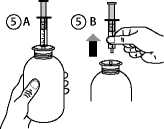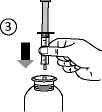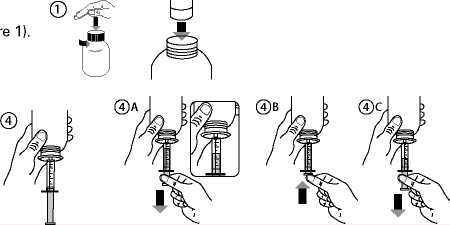Levetiracetam Rosemont 100Mg/Ml Oral Solution
Read all of this leaflet carefully before you start taking this medicine because it contains important information for you.
■ Keep this leaflet. You may need to read it again.
■ If you have any further questions, ask your doctor or pharmacist.
■ This medicine has been prescribed for you only. Do not pass it on to others. It same as yours.
■ If you get any side effects talk to your doctor or pharmacist. This includes any What is in this leaflet:
1. What Levetiracetam Oral Solution is and what it is used for
2. What you need to know before you take Levetiracetam Oral Solution
3. How to take Levetiracetam Oral Solution
4. Possible side effects
5. How to store Levetiracetam Oral Solution
6. Contents of the pack and other information
may harm them, even if their signs of illness are the possible side effects not listed in this leaflet.
Levetiracetam 100mg/ml Oral Solution is an anti-epileptic medicine (a medicine used to treat seizures in epilepsy).
Levetiracetam is used:
■ on its own in adults and adolescents from 16 years of age with newly diagnosed epilepsy, to treat partial onset seizures with or without secondary generalisation.
■ as an add-on to other antiepileptic medicines to treat:
- partial onset seizures with or without generalisation in adults, adolescents, children and infants from one month of age
- myoclonic seizures in adults and adolescents from 12 years of age with juvenile myoclonic epilepsy
- primary generalised tonic-clonic seizures in adults and adolescents from 12 years of age with idiopathic generalised epilepsy.
Do not take Levetiracetam:
■ If you are allergic (hypersensitive) to levetiracetam or any of the other ingredients of this medicine (listed in Section 6).
Warnings and Precautions
Talk to your doctor before taking Levetiracetam
■ If you suffer from kidney problems, follow your doctor's instructions. He/she may decide if your dose should be adjusted.
■ If you notice any slow down in the growth or unexpected puberty development of your child, please contact your doctor.
■ If you notice an increase in seizure severity (e.g. increased number), please contact your doctor.
■ A small number of people being treated with anti-epileptics such as Levetiracetam have had thoughts of harming or killing themselves. If you have any symptoms of depression and/or suicidal ideation, please contact your doctor.
Other medicines and Levetiracetam
Please tell your doctor or pharmacist if you are taking or have recently taken any other medicines, including medicines obtained without a prescription.
Taking Levetiracetam Oral Solution with food, drink and alcohol
You may take Levetiracetam with or without food. As a safety precaution, do not take Levetiracetam with alcohol.
Pregnancy and breast-feeding
■ Ask your doctor or pharmacist for advice before taking any medicine.
■ If you are pregnant or if you think you may be pregnant, please inform your doctor.
■ Levetiracetam should not be used in pregnancy unless clearly necessary. The potential risk to your unborn baby is unknown. Levetiracetam has shown unwanted reproductive effects in animal studies at dose levels higher than you would need to control your seizures.
■ Breast-feeding is not recommended during treatment.
Driving and using machines
■ Levetiracetam may impair your ability to drive or operate any tools or machinery, as Levetiracetam may make you feel sleepy.
■ This is more likely at the beginning of your treatment or after an increase in the dose.
■ You should not drive or use machines until it is established that your ability to perform such activities is not affected.
Levetiracetam Oral Solution contains methyl parahydroxybenzoate, propyl parahydroxybenzoate and maltitol
■ Levetiracetam Oral Solution includes methyl parahydroxybenzoate (E218) and propyl parahydroxybenzoate (E216) which may cause allergic reactions (possibly delayed).
■ Levetiracetam Oral Solution also contains maltitol. If you have been told by your doctor that you have an intolerance to some sugars, contact your doctor before taking this medicinal product.
Always take this medicine exactly as your doctor or pharmacist has told you. Check with your doctor or pharmacist if you are not sure. Levetiracetam Oral Solution must be taken twice a day, once in the morning and once in the evening, at about the same time each day.
Take the oral solution following your doctor's instructions.
Monotherapy
Dose in adults and adolescents (from 16 years of age):
■ General dose: between 10 ml (1,000 mg) and 30 ml (3,000 mg) each day, divided in 2 intakes per day.
■ When you first start taking Levetiracetam, your doctor will prescribe you a lower dose during 2 weeks before giving you the lowest general dose.
Add-on therapy
Dose in adults and adolescents (12 to 17 years) weighing 50 kg or more:
■ General dose: between 10 ml (1,000 mg) and 30 ml (3,000 mg) each day, divided in 2 intakes per day.
Dose in infants (6 to 23 months), children (2 to 11 years) and adolescents (12 to 17 years) weighing less than 50 kg:
■ Your doctor will prescribe the most appropriate pharmaceutical form of Levetiracetam according to the age, weight and dose.
■ General dose: between 0.2 ml (20 mg) and 0.6 ml (60 mg) per kg bodyweight each day, divided in 2 intakes per day.
■ The exact quantity of oral solution should be delivered using the syringe provided in the cardboard box.
|
Weight |
Starting dose: 0.1ml/kg twice daily |
Maximum dose: 0.3ml/kg twice daily |
|
6 kg |
0.6 ml twice daily |
1.8 ml twice daily |
|
8 kg |
0.8 ml twice daily |
2.4 ml twice daily |
|
10 kg |
1 ml twice daily |
3 ml twice daily |
|
15 kg |
1.5 ml twice daily |
4.5 ml twice daily |
|
20 kg |
2 ml twice daily |
6 ml twice daily |
|
25 kg |
2.5 ml twice daily |
7.5 ml twice daily |
|
From 50 kg |
5 ml twice daily |
15 ml twice daily |
Dose in infants (1 month to less than 6 months)
■ General dose: between 0.14 ml (14 mg) and 0.42 ml (42 mg) per kg bodyweight each day, divided in 2 intakes per day.
■ The exact quantity of oral solution should be delivered using the syringe provided in the cardboard box.
|
Weight |
Starting dose: 0.07ml/kg twice daily |
Maximum dose: 0.21ml/kg twice daily |
|
4 kg |
0.3 ml twice daily |
0.85 ml twice daily |
|
5 kg |
0.35 ml twice daily |
1.05 ml twice daily |
|
6 kg |
0.45 ml twice daily |
1.25 ml twice daily |
|
7 kg |
0.5 ml twice daily |
1.5 ml twice daily |
Method of administration:
Levetiracetam Oral Solution may be diluted in a glass of water or baby's bottle. Instructions for use
eV d 1
■ Fill the syringe with a small amount of solution by pulling the piston down (figure 4A), then push the piston upward in order to remove any possible bubbles (figure; 4B). Pull the piston down to the graduation mark corresponding to the quantity in millilitres (ml) prescribed by your doctor (figure 4C).
■ Turn the bottle the right way up (figure 5A).
Remove the syringe from the adaptor (figure 5B).

■ Empty the contents of the syringe into a glass of water or baby's bottle by pushing the piston to the bottom of the syringe (figure 6).
■ Drink the whole contents of the glass/baby's bottle. (£ 7
■ Close the bottle with the plastic screw cap. _
■ Wash the syringe with water only (figure 7). ^ ''c=^r> \
Duration of treatment:
■ Levetiracetam is used as a chronic treatment. You should continue Levetiracetam treatment for as long as your doctor has told you.
■ Do not stop your treatment without your doctor's advice as this could increase your seizures. Should your doctor decide to stop your Levetiracetam treatment, he/she will instruct you about the gradual withdrawal of Levetiracetam.
If you take more Levetiracetam than you should:
■ The possible side effects of an overdose of Levetiracetam are sleepiness, agitation, aggression, decrease of alertness, inhibition of breathing and coma.
■ Contact your doctor if you took more Levetiracetam than you should. Your doctor will establish the best possible treatment of overdose.
If you forget to take Levetiracetam:
■ Contact your doctor if you have missed one or more doses.
■ Do not take a double dose to make up for a forgotten dose.
If you stop taking Levetiracetam:
If stopping treatment, as with other anti-epileptic medicines, Levetiracetam should be discontinued gradually to avoid an increase of seizures. If you have any further questions on the use of this product, ask your doctor or pharmacist.


Like all medicines, this medicine can cause side effects, although not everybody gets them.
Some of the side effects like sleepiness, tiredness and dizziness may be more common at the beginning of the treatment or at dose increase. These effects should however decrease over time.
Very common: may affect more than 1 user in 10
■ nasopharyngitis;
■ somnolence (sleepiness), headache.
Common: may affect 1 to 10 users in 100
■ anorexia (loss of appetite);
■ depression, hostility or aggression, anxiety, insomnia, nervousness or irritability;
■ convulsion, balance disorder (equilibrium disorder), dizziness (sensation of unsteadiness), lethargy, tremor (involuntary trembling);
■ vertigo (sensation of rotation);
■ cough;
■ abdominal pain, diarrhoea, dyspepsia (indigestion), vomiting, nausea;
■ rash;
■ asthenia/fatigue (tiredness).
Uncommon: may affect 1 to 10 users in 1000
■ decreased number of blood platelets, decreased number of white blood cells;
■ weight decrease, weight increase;
■ suicide attempt and suicidal ideation, mental disorder, abnormal behaviour, hallucination, anger, confusion, panic attack, emotional instability/mood swings, agitation;
■ amnesia (loss of memory), memory impairment (forgetfulness), abnormal coordination/ataxia (impaired coordinated movements), paraesthesia (tingling), disturbance in attention (loss of concentration);
■ diplopia (double vision), vision blurred;
■ liver function test abnormal;
■ hair loss, eczema, pruritus;
■ muscle weakness, myalgia (muscle pain);
■ injury.
Rare: may affect 1 to 10 users in 10,000
■ infection;
■ decreased number of all blood cell types;
■ severe hypersensitivity reactions (DRESS);
■ decreased blood sodium concentration;
■ suicide, personality disorders (behavioural problems), thinking abnormal (slow thinking, unable to concentrate);
■ uncontrollable muscle spasms affecting the head, torso and limbs, difficulty in controlling movements, hyperkinesia (hyperactivity);
■ pancreatitis;
■ hepatic failure, hepatitis;
■ skin rash, which may form blisters and looks like small targets (central dark spots surrounded by a paler area, with a dark ring around the edge) (erythema multiforme), a widespread rash with blisters and peeling skin, particularly around the mouth, nose, eyes and genitals (Stevens-Johnson syndrome), and a more severe form causing skin peeling in more than 30% of the body surface (toxic epidermal necrolysis).
Reporting of side effects
If you get any side effects, talk to your doctor or pharmacist. This includes any possible side effects not listed in this leaflet. You can also report side effects directly (see details below). By reporting side effects you can help provide more information on the safety of this medicine.
United Kingdom
Yellow Card Scheme
Website: www.mhra.gov.uk/yellowcard
Ireland
HPRA Pharmacovigilance Earlsfort Terrace, IRL - Dublin 2 Tel: +353 1 6764971 Fax: +353 1 6762517 Website: www.hpra.ie e-mail: medsafety@hpra.ie
■ Keep this medicine out of the sight and reach of children.
■ Do not use this medicine after the expiry date (month, year) stated on the label and carton after EXP. The expiry date refers to the last day of that month.
■ Do not use after 7 months of first opening the bottle.
■ This medicinal product does not require any special storage conditions.
■ Do not throw away any medicines via wastewater or household waste. Ask your pharmacist how to throw away medicines you no longer use. These measures will help protect the environment.
■ Insert the adaptor into the bottle neck (figure 2). Ensure it is well fixed.
■ Take the syringe and put it in the adaptor opening (figure 3).
Turn the bottle upside down (figure 4).
P0742


What Levetiracetam Solution contains
■ The active ingredient is levetiracetam. This medicine contains 100mg of levetiracetam in each 1ml of solution.
■ The other ingredients are acesulfame potassium (E950), ammonium glycyrrhizinate, citric acid (E330), glycerol (E422), liquid maltitol (E965), methyl parahydroxybenzoate (E218), propyl parahydroxybenzoate (E216), sodium citrate (E331), grape flavour and purified water.
What Levetiracetam Solution looks like and contents of the pack
Levetiracetam 100mg/ml Oral Solution is a clear colourless liquid.
■ 300ml pack (for children aged 4 years and above, adolescents and adults). A 300ml brown glass bottle is packed in a cardboard box containing a 12ml oral syringe (graduated every 0.25ml) and an adaptor for the syringe.
■ 150ml pack (for infants and young children aged from 6 months to less than 4 years). A 150ml brown glass bottle packed in a cardboard box containing a 3ml oral syringe (graduated every 0.1ml) and an adaptor for the syringe.
■ 150ml pack (for infants aged 1 month to less than 6 months). A 150ml brown glass bottle packed in a cardboard box containing a 1ml oral syringe (graduated every 0.05ml) and an adaptor for the syringe.
Marketing Authorisation Holder and Manufacturer
Marketing Authorisation Holder: Rosemont Pharmaceuticals Ltd, Yorkdale Industrial Park, Braithwaite Street, Leeds, LS11 9XE, UK.
Manufacturer: MEDANA PHARMA SA., 10, Wt. iokietka Street, 98-200 Sieradz, POLAND
This medicinal product is authorised in the Member State of the EEA under the following names:
Levetiracetam 100mg/ml Oral Solution: UK
Levetiracetam 100mg/ml Oral Solution: Eire
This leaflet was last revised in 08/2014
P0742